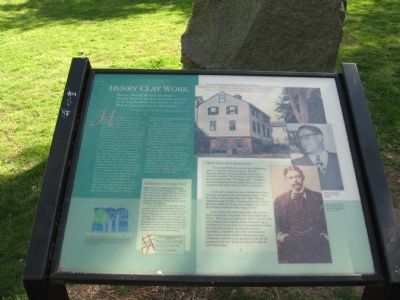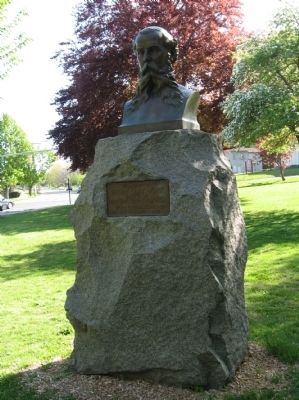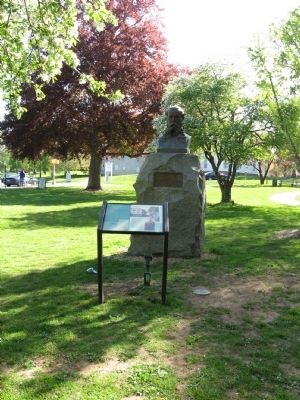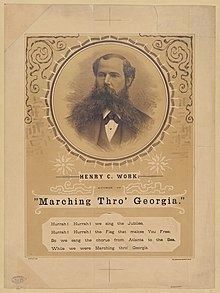Middletown in Middlesex County, Connecticut — The American Northeast (New England)
Henry Clay Work
“Hurrah! Hurrah! We bring the Jubilee.
Hurrah! Hurrah! The flag that makes you free!
Se we sang the chorus from Atlanta to the sea,
While we were marching through Georgia”
“Marching through Georgia,” by Henry Clay Work
Henry Clay Work was born in Middletown in 1832, the son of an impassioned abolitionist named Alanson Work. When Henry was about three years old, his father moved the family to Illinois so that he could help slaves escape to Canada on the Underground Railroad. During the next few years, Alanson Work helped over 3,000 slaves reach freedom, and finally was arrested and imprisoned for his activities. After his release from prison, Alanson Work brought his family back to Middletown for several years.
When Henry Clay Work grew up, he worked as a printer in Hartford and Chicago. In his spare time, he taught himself music and began composing songs. Before long, his first song was published; in the decades following, Work penned some of the 19th century’s favorite tunes. Many focused on social issues of the time, such as the temperance movement or the condition of African Americans. In 1865, Work wrote “Marching through Georgia,” a Civil War anthem celebrating Union General William T. Sherman’s 1864 campaign that destroyed Confederate supplies, liberated slaves and helped bring about the South’s surrender.
Henry Clay Work’s most popular composition was “Grandfather’s Clock,” a sentimental ballad about his grandfather’s “treasure and pride,” a tall clock that “stopped short, never to go again, When the old man died.” The 1875 song sold nearly a million copies and earned the then considerable sum of $4,000 in royalties.
Despite his success as a songwriter, Henry Clay Work’s life had many tragedies: three of his children died young, his wife lost her sanity and had to be institutionalized, and Work lost nearly all of his money in two ill-fated investments. In 1881, the composer died in Hartford after writing over seventy songs. People around the world still sing some of them today.
Middletown Heritage Trail
Welcome to the Middletown Heritage Trail! You’ll find “stations” like this one throughout the downtown area. Each gives a brief glimpse into the city’s past, recounting stories about interesting people, places, and events in Middletown’s history. You can follow the Heritage Trail as a whole, or just visit individual stations. An overview of the Trail is located beside Police Headquarters at 222 Main Street. Heritage Trail brochures are available at the Middletown Police Headquarters, the Middlesex Chamber of Commerce (393 Main Street), the Russell Library
(123 Broad Street) and the Middlesex Historical Society (151 Main Street).
More Music from Middletown
Henry Clay Work was not the only Middletown native to influence American music. In Reginald deKoven composed the first important American operetta, “Robin Hood, “ which featured the ever-popular song, “O, Promise Me.” DeKoven, who had studied music throughout Europe, was a conductor and music critic as well as a composer. In the 20th century two more Middletown natives drew the spotlight in the entertainment scene. From the 1930s to the 1960s, Elias Paul “Allie” Wrubel composed songs for film, including the jaunty “Zip-A-Dee-Doo Dah” for “Song of the South, “ which won the Academy Award for Best Song of 1947. Tony Pastor serenaded Americans with his saxophone during the “Big Band” era of the thirties and forties. Born Antonio Pestritto in 1907 to parents who had emigrated from Melilli, Sicily, Tony grew up in Middletown’s North End. He took saxophone lessons first from Allie Wrubel, and later from Lucio Pandolfini, a Melillese native who had studied at Italy’s Conservatory of Music. Young Tony soon crashed the national scene, gaining acclaim for his exceptional solo on “Begin the Beguine” with the Artie Shaw Band.
Erected by the Middlesex County Historical Society.
Topics. This historical marker is listed in this topic list: Arts, Letters, Music.
Location. 41° 33.384′ N, 72° 38.897′ W. Marker is in Middletown, Connecticut, in Middlesex County. Marker is at the intersection of Main Street and Pleasant Street, on the right when traveling south on Main Street. Located in Union Park. Touch for map. Marker is in this post office area: Middletown CT 06457, United States of America. Touch for directions.
Other nearby markers. At least 8 other markers are within walking distance of this marker. Middletown Soldiers Monument (within shouting distance of this marker); Middletown and the Civil War (within shouting distance of this marker); Middletown (within shouting distance of this marker); Near This Site In 1750 (about 300 feet away, measured in a direct line); Danforth Pewter Shop (about 300 feet away); Congregation Adath Israel (about 300 feet away); The General Mansfield House (about 400 feet away); Middletown Honor Roll (about 500 feet away). Touch for a list and map of all markers in Middletown.
Also see . . . Henry Clay Work. Wikipedia entry (Submitted on August 22, 2013, by Michael Herrick of Southbury, Connecticut.)
Credits. This page was last revised on February 6, 2022. It was originally submitted on August 22, 2013, by Michael Herrick of Southbury, Connecticut. This page has been viewed 736 times since then and 38 times this year. Photos: 1, 2, 3. submitted on August 22, 2013, by Michael Herrick of Southbury, Connecticut. 4. submitted on October 12, 2020, by Larry Gertner of New York, New York.



